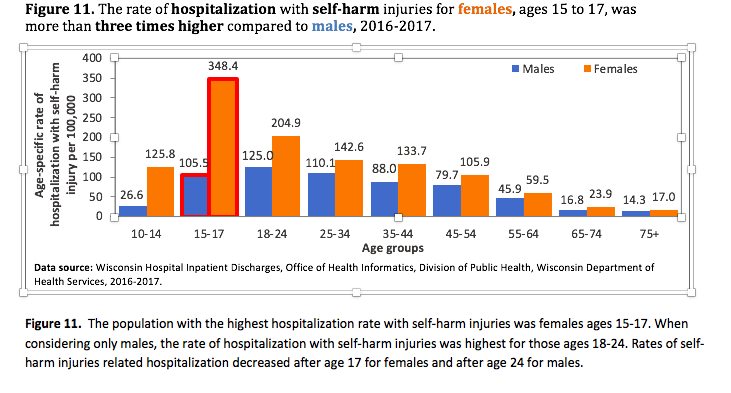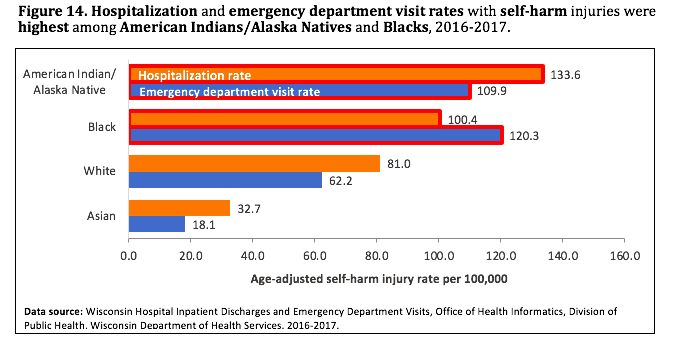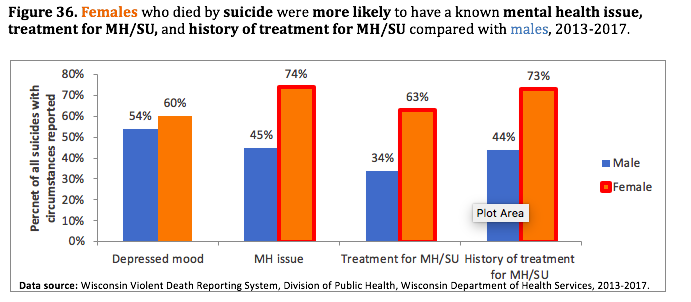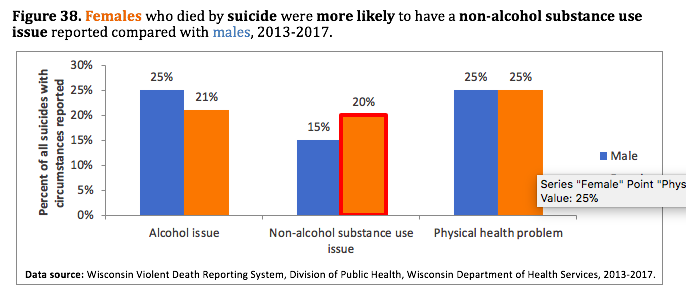National Data
CDC Report - Suicide Rates on the Rise Nationally
This report summarizes national suicide death data for both women and men from the years 2000-2016. To highlight some of the key findings regarding suicide in women:
In 2016, the means of suicide among females varied by age group.
- Among females aged 10–14, the most frequent means of suicide in 2016 was suffocation (119 of 171 deaths or 70%)
- Nearly three-quarters of all suicides among females aged 15–24 involved either suffocation (509 of 1,148 deaths or 44%) or firearms (335 deaths or 29%).
- Among females aged 25–44, 32% (1,035 of 3,215 deaths) of suicides involved firearms, 31% involved suffocation (1,004 deaths), and 28% involved poisoning (887 deaths).
- Poisoning was the most frequent means of suicide among females aged 45 and over, accounting for 40% of suicides among those aged 45–64 (1,720 of 4,253 deaths), 41% among those aged 65–74 (381 of 940 deaths), and 37% among those aged 75 and over (188 of 510 deaths).
- Firearms were the second most frequent means of suicide among females aged 45 and over, accounting for 32% of suicides among those aged 45–64 (1,361 of 4,253 deaths), 38% among those aged 65–74 (358 of 940 deaths), and 33% among those aged 75 and over (168 of 510 deaths)
WI Specific Data
Significance of Self-Harm (Harming oneself without intention to die)
"Men are at a greater risk of dying from suicide than women. In contrast, women are seen in hospitals and emergency departments for suicide attempts and other self-harm injuries more often than men." (Suicide in WI Report, 2020)

"In addition to the sex and age disparities, data reveal additional subpopulations whose risk for suicide or self-inflicted injuries may be elevated. Self-harm injury rates were highest among Blacks and American Indians/Alaskan Natives. "

Significance of Mental Health Issues & Substance Abuse


Resources Related to Women's Suicide Prevention
Guide on Lethal Means and Suicide Prevention Released
Reducing access to lethal means, such as firearms and medication, can determine whether a person at risk for suicide lives or dies. Mental health professionals and laypeople alike can learn how to work with suicidal individuals to reduce their access to means. Counseling on Access to Lethal Means is a free online course that covers how to: identify people who could benefit from lethal means counseling; ask about their access to lethal methods; and work with them—and their families and friends—to reduce access.
Resources Related to Self-Harm
Supporting People who Self-Harm Webinar by Wildflower Alliance
A 3-hour webinar on self-injury featuring Ruta Mazelis, Ebony Flint, Cindy Hadge, and Sera Davidow as sponsored by the Wildflower Alliance (formerly known as the Western Mass Recovery Learning Community or RLC).
Crisis Textline's Self-Harm Info Page
Overview of different types of self-harm behaviors and symptoms and how to deal with self-harm behaviors.
Crisis Textline: Text HOPELINE to 741741 to be connected with a crisis counselor
Calm Harm is an award-winning app developed for teenage mental health charity stem4 by Dr Nihara Krause, Consultant Clinical Psychologist, using the basic principles of an evidence-based therapy called Dialectical Behavioural Therapy (DBT). Calm Harm provides tasks to help you resist or manage the urge to self-harm. You can make it private by setting a password, and personalize the app if you so wish. You will be able to track your progress and notice change. Please note the app is an aid in treatment but does not replace it.